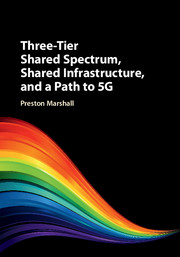Book contents
- Frontmatter
- Contents
- Acknowledgments
- Preface
- Part I Spectrum Sharing Background
- Part II Three-Tier Dynamic Spectrum Models
- Part III Components of a Three-Tier Architecture
- Part IV Protection Processes for Incumbents and Peers
- Part V Example Use of Three-Tier Spectrum: Use of the 3.5 GHz CBRS Band in the USA
- Part VI Future Bands, Network Services, Business Models, and Technology
- 15 Potential Services and Business Models Enabled by Three-Tier Spectrum
- 16 Candidate Incumbent Bands for Three-Tier Spectrum Sharing
- 17 From Shared Spectrum, to Shared Infrastructure, to a New Model of 5G
- 18 Future Actions to Deploy More Three-Tier Spectrum Bands and Nations
- 19 Alternatives to Three-Tier Operation
- 20 Conclusions and a Look Ahead
- Part VII Appendices
- Index
- References
16 - Candidate Incumbent Bands for Three-Tier Spectrum Sharing
from Part VI - Future Bands, Network Services, Business Models, and Technology
Published online by Cambridge University Press: 30 August 2017
- Frontmatter
- Contents
- Acknowledgments
- Preface
- Part I Spectrum Sharing Background
- Part II Three-Tier Dynamic Spectrum Models
- Part III Components of a Three-Tier Architecture
- Part IV Protection Processes for Incumbents and Peers
- Part V Example Use of Three-Tier Spectrum: Use of the 3.5 GHz CBRS Band in the USA
- Part VI Future Bands, Network Services, Business Models, and Technology
- 15 Potential Services and Business Models Enabled by Three-Tier Spectrum
- 16 Candidate Incumbent Bands for Three-Tier Spectrum Sharing
- 17 From Shared Spectrum, to Shared Infrastructure, to a New Model of 5G
- 18 Future Actions to Deploy More Three-Tier Spectrum Bands and Nations
- 19 Alternatives to Three-Tier Operation
- 20 Conclusions and a Look Ahead
- Part VII Appendices
- Index
- References
Summary
Introduction
This chapter will survey a number of spectrum bands for their applicability to the three-tier spectrum sharing regime developed earlier in this book, and in terms of the incumbent usage. Some of the bands are not apparent candidates for sharing, but are included for purposes of discussion, and to demonstrate methodology.
The complexity of a generalized approach to three-tier spectrum is apparent when one considers the balkanized nature of primary and secondary national spectrum assignments. The National Telecommunications and Information Agency (NTIA) map of these assignments [1] in the United States of America (USA) is shown in Figure 16.1. Although it is hard to read in this book's reduced, gray-scale printing, the complexity of the chart, the division of spectrum into uniquely managed spectrum slivers, and the range of uses of most of the individual frequencies is readily apparent. Undoing this legacy of partitioning and stacking of fixed rights to spectrum access is not a trivial challenge, particularly when, in most cases, the existing structure must continue to operate, even in the presence of the new regime.
Because of the myriad of unique bands, and primary/secondary/tertiary usage permutations, the discussion in this chapter will initially focus mostly on the characteristics of different allocation categories and usage, rather than specific bands.With the discussion of specific sharing and protection constraints completed, the results will then be mapped to the International Telecommunication Union (ITU) international allocations.
Even with this structure, individual National Regulatory Authority (NRA) decisions have established unique national primary and secondary allocations in many bands, so the results of this chapter must be further reconciled with national practices. For example, many countries do not use several of these allocation types at all. International agreement on reallocation may not be possible, but might not be required for action by individual nations, so long as not interfering with international commitments.
Evaluation Criteria for Considering Opportunities for Three-Tier Spectrum
It is necessary to have a scientific, evidence-based process to determine what bands are good candidates for three-tier spectrum, and which ones are really unsuited to such a regime. Spectrum politics often obscures the fundamental technical issues, and the basis and outcomes of decision-making are not always driven by the scientific reality, unfortunately.
- Type
- Chapter
- Information
- Publisher: Cambridge University PressPrint publication year: 2017



